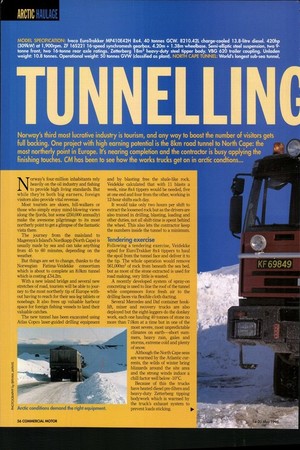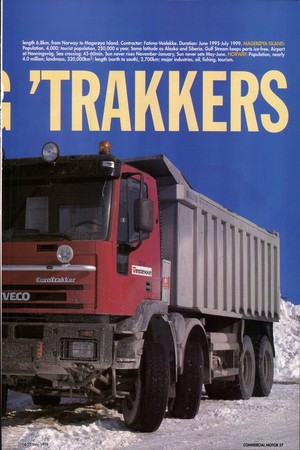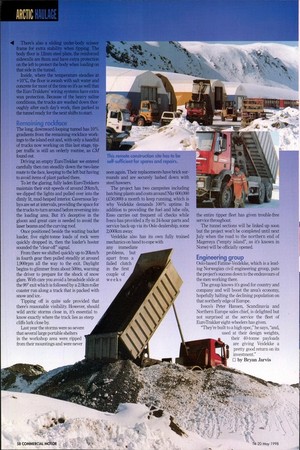NELL N TffillitKERS Norway's third most lucrative industry is tourism,
Page 68

Page 69

Page 70

If you've noticed an error in this article please click here to report it so we can fix it.
and any way to boost the number of visitors gets full backing. One project with high earning potential is the 8km road tunnel to North Cape: the most northerly point in Europe. It's nearing completion and the contractor is busy applying the finishing touches. CM has been to see how the works trucks get on in arctic condtions...
N"'" orway's four-million inhabitants rely heavily on the oil industry and fishing to provide high living standards. But while they're both big earners, foreign visitors also provide vital revenue.
Most tourists are skiers, hill-walkers or those who simply enjoy mind-blowing views along the fjords, but some (250,000 annually) make the awesome pilgrimage to its most northerly point to get a glimpse of the fantastic vista there.
The journey from the mainland to Mageroya's Island's Nordkapp (North Cape) is usually made by sea and can take anything from 45 to 60 minutes, depending on the weather.
But things are set to change, thanks to the Norwegian Fatima-Veidekke consortium which is about to complete an 8.0km tunnel which is costing £54.2m.
With a new island bridge and several new stretches of road, tourists will be able to journey to the most northerly tip of Europe without having to reach for their sea-leg tablets or nosebags. It also frees up valuable harbour space for foreign fishing vessels to land their valuable catches.
The new tunnel has been excavated using Atlas Copco laser-guided drilling equipment and by blasting free the shale-like rock. Veidekke calculated that with 11 blasts a week, nine 8x4 tippers would be needed, five at one end and four from the other, working in 12-hour shifts each day.
It would take only two hours per shift to extract the loosened rock but as the drivers are also trained in drilling, blasting, loading and other duties, not all shift-time is spent behind the wheel. This also lets the contractor keep the numbers inside the tunnel to a minimum.
Tendering exercise Following a tendering exercise, Veidekke opted for EuroTrakker 8x4 tippers to haul the spoil from the tunnel face and deliver it to the tip. The whole operation would remove 561,000m3 of rock from beneath the sea bed, but as most of the stone extracted is used for road making, very little is wasted.
A recently developed system of spray-on concreting is used to line the roof of the tunnel while compressors force fresh air to the drilling faces via flexible cloth ducting.
Several Mercedes and Daf container hooka( mixer and recovery trucks are also deployed but the eight-leggers do the donkey work, each one hauling 40 tonnes of stone no more than 7.0km at a time but in one of the most severe, most unpredictable climates on earth—short summers, heavy rain, gales and storms, extreme cold and plenty of snow.
Although the North Cape seas are warmed by the Atlantic currents, the wilds of winter bring blizzards around the site area and the strong winds induce a chill factor well below -10°C.
Because of this the trucks have heated diesel pre-filters and heavy-duty Zetterberg tipping bodywork which is warmed by the truck's exhaust system to prevent loads sticking. There's also a sliding under-body scissor frame for extra stability when tipping. The body floor is 12mm steel plate, the reinforced sidewalls are 8mm and have extra protection on the left to protect the body when loading on that side in the tunnel.
Inside, where the temperature steadies at +10°C, the floor is awash with salt water and concrete for most of the time so it's as well that the EuroTrakkers' wiring systems have extra wax protection. Because of the heavy saline conditions, the trucks are washed down thoroughly after each day's work, then parked in the tunnel ready for the next shifts to start.
The long, downward-looping tunnel has 10% gradients from the remaining rockface workings to the island exit and, with only a handful of trucks now working on this last stage, tipper traffic is still an orderly routine, as CM found out.
Driving an empty EuroTrekker we entered carefully then ran steadily down the two-lane route to the face, keeping to the left but having to avoid items of plant parked there.
To let the glaring, fully laden EuroTrekkers maintain their exit speeds of around 20km/h, we dipped the lights and pulled over into the dimly lit, mud-heaped interior. Cavernous laybys are set at intervals, providing the space for the trucks to turn around before reversing into the loading area. But it's deceptive in the gloom and great care is needed to avoid the laser beams and the curving roof.
Once positioned beside the waiting bucket loader, five eight-tonne loads of rock were quickly dropped in, then the loader's hooter sounded the "clear-off" signal.
From there we shifted quickly up to 20km/h in fourth gear then pulled steadily at around 1,900rpm all the way to the exit. Daylight begins to glimmer from about 500m, warning the driver to prepare for the shock of snow glare. With care you avoid a broadside slide at the 90° exit which is followed by a 2.0km roller coaster run along a track that is packed with snow and ice..
Tipping off is quite safe provided that there's reasonable visibility. However, should wild arctic storms close in, it's essential to know exactly where the track lies as steep cliffs lurk close by.
Last year the storms were so severe that several large portable shelters in the workshop area were ripped from their mountings and were never seen again. Their replacements have brick surrounds and are securely lashed down with steel hawsers.
The project has two campsites including batching plants and costs around Nkr 600,000 (£50,000) a month to keep running, which is why Veidekke demands 100% uptime. In addition to providing the fuel and lube oils, Esso carries out frequent oil checks while Iveco has provided a fly-in 24-hour parts and service back-up via its Oslo dealership, some 2,000km away.
Veidekke also has its own fully trained mechanics on hand to cope with any immediate problems, but apart from a failed clutch in the first couple of weeks the entire tipper fleet has given trouble-free service throughout.
The tunnel sections will be linked up soon but the project won't be completed until next July when the road to the northern end of Mageroya ("empty island", as it's known in Norse) will be officially opened.
Engineering group Oslo-based Fatime-Veidekke, which is a leading Norwegian civil engineering group, puts the project's success down to the endeavours of the men working there.
The group knows it's good for country and company and will boost the area's economy, hopefully halting the declining population on that northerly edge of Europe.
Iveco's Peter Hansen, Scandinavia and Northern Europe sales chief, is delighted but not surprised at the service the fleet of EuroTrakker eight-wheelers has given. "They're built to a high spec," he says, "and, used at their design weights, their 40-tonne payloads are giving Veidekke a pretty good return on its investment."
121 by Bryan Jarvis




































































































































